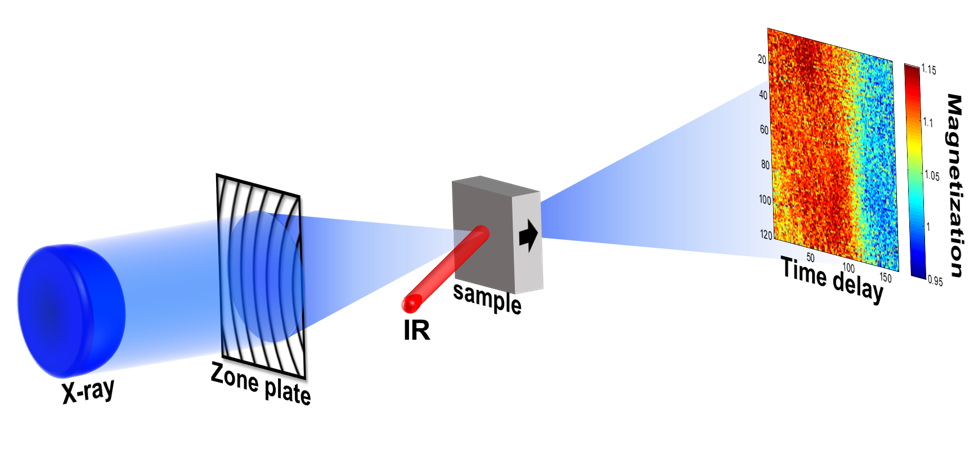After a PhD at Institu Néel on the depth magnetic profile of ultra-thin films I get interested in the ultrafast magnetism dynamics by performing a post-doctorate at Stanford-SLAC and then at Laboratoire Chimie Physique - Matiere et Rayonnement (Paris, UPMC), in which I am now Chargee de Recherche (Staff Scientist) in the group "Systèmes Fortements Corrélés - Matériaux Magnétiques". To probe magnetism with a spatial (nm) and time (fs) resolution I am using high harmonic generation, synchrotron, or free-electron laser (FEL) sources in a pump-probe geometry.
Phone: +33 (0)1 44 27 66 17
email: emmanuelle.jal@sorbonne-universite.fr
Orcid: 0000-0001-5297-9124
Interplay of structural and magnetic ultrafast dynamics
Most experiments focused so far on characterizing magnetization and charge carrier dynamics, while the first direct measurements of structural dynamics during ultrafast demagnetization were reported only very recently. I have investigated the infrared laser-pulse-induced ultrafast demagnetization process in a thin Ni film. To bring new information we have employed resonant magnetic x-ray reflectivity to follow simultaneously magnetization and structural dynamics at the BESSY femtoslicing source. We found that significant changes in nonmagnetic x-ray reflectivity accompany the subpicosecond demagnetization, which can be modeled as a variation of film thickness. We are further investigating what is at the origin of an ultrafast contraction and if this phenomenon depends on the magnetic layer and/or cap layer.

Figure 1: TR-XRMR principle and non-magnetic reflected intensity and normalized magnetization as a function of time delay for a reflected angle of 10.9°. In red, Ni thickness as a function of time delay for the upper panel, and exponential fitting for the lower panel.
Our simulations further show that the higher photon flux and energy resolution provided by x-ray free-electron lasers will yield decisive data to differentiate between different mechanisms proposed to govern ultrafast demagnetization dynamics. Indeed, the XRMR technique allows deriving a depth magnetic profile (see past research). Being able to perform time-resolved measurements at different angles and energy will allow us to retrieve the time and depth-resolved magnetic profile during the ultrafast dynamics. That information will allow to confirm or infirm different theoretical models.
X-ray streaking to capture the time-resolved ultrafast phenomenon in one shot
In normal pump-probe experiment, one needs to repeat the measurement for each time delay to get a complete demagnetization curve. We have developed a new experimental approach based on the use of a zone plate to streak the photons. The concept is shown in figure 2. In one single shot of XUV, the pathway of the photons coming from the right and the left side of the zone plate is not the same, inducing a time delay with the infrared pulse. We look then to the XUV magnetic circular dichroism signal thanks to a 2D detector (CCD).

Figure 2: X-ray streaking principle. The zone plate focuses the XUV pulse onto the sample where an infrared pulse is coming at the same time. The path difference for the photons coming from the right and the left of the zone plane can be directly converted to the time delay between the XUV and IR. The magnetization signal is simply the circular dichroism of the sample since the XUV pulse is circularly polarized and the sample magnetization is out of plane.
For normalization purpose, we are using the -1 order of the zone plate and a second detector. This development and experiment have been done at FERMI on the DiProI beamline in close collaboration with the beamline scientist Flavio Capotondi and the PSI which have provided the zone plate (Christian David).
Probing simultaneously magnetic and electronic dynamics at L-edges of transition metals using FERMI Free Electron Laser
In order to bring new experimental evidence in the understanding of ultrafast demagnetization, probing the spin and electron sub-systems simultaneously is necessary. Since the advent of free-electron laser sources, pure absorption measurements have been challenging until recently [1,2] due to the intrinsic fluctuation of the photon parameters and the lack of a reliable and linear I0 detector. As a result, while a lot of scattering investigations have been published and brought new insight into the understanding of ultrafast phenomena [2], few purely spectroscopic studies have been performed on thin magnetic films at FEL. However, time-resolved absorption experiments have shown promising results, such as a shift of the absorption peak at the same time scale than ultrafast demagnetization occurs [4,5]. In order to investigate the interplay between the strong electronic and magnetic dynamics, we developed a new experimental approach based on ad-hoc diffraction gratings to probe simultaneously the x-ray absorption and magnetic scattering of CoPt and FeTb samples with linearly polarized x-rays using the 3rd harmonic of FERMI’s FEL-2.

Figure 3: (a) Experimental setup with real CCD picture for a CoPt multilayer sample. (b-c) static and pumped absorption (black and red resp.) as well as magnetization (blue) as a function of time delay Δt at 707.5 eV for the FeTb sample (b) and as a function of probing energies for CoPt sample for unpump (dark) and 0.5 ps after the pump (light) conditions (c).
To obtain a quantitative magnetic scattering signal, we used magnetic thin multilayers having stripe magnetic domains out of plane, while we used two gratings to disperse the incident intensity into different diffraction orders that generate a different spatially separated replica of the input beam. Such replica can be used to extract the static and the pumped absorption, as well the evolution of the magnetic properties of the sample as depicted in Figure 1a. The delay traces of the recorded magnetization, static absorption, and pumped absorption are shown in Figure 1b. In order to see a potential shift of the x-ray absorption, as well as a potential change of the demagnetization rate and time scale as a function of the probing energy, we also performed energy scans at different time delays, by tuning the wavelength of the seed laser (Figure 1c). First results seem to indicate that at L edges of Co and Fe, the demagnetization time doesn’t depend on the probing energy. Additionally to this scientific outcome, this experiment allowed us to characterize the beam properties of the 3rd harmonic of FERMI’s FEL-2, which will be very useful to perform future scattering experiments at shorter wavelengths to gain spatial resolution.
